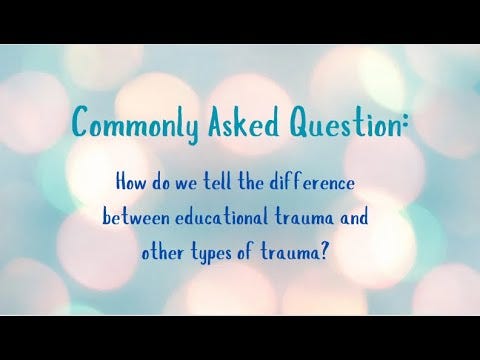Commonly Asked Questions #1
How do we tell the difference between educational trauma and other kinds of trauma?
This is the first in my Commonly Asked Questions series, If you have a question you’d like me to reframe and answer, leave it in the comments and I’ll give it a run!
Reframe
“What information about lived traumatic experience do teachers truly need to support students?”
Why reframe the question?
“How do we tell the difference between educational trauma and other kinds of trauma?” is one of those questions that isn’t verbalized often, but lurks at the heart of many conversations about educational trauma. Well, to the extent that we’re having those conversations because we mostly aren’t, yet. But those conversations are growing, so how should we think about trauma in the classroom, especially from a non-therapeutic perspective?
The general response to that reframe is “Doesn’t knowing how to tell the difference between educational trauma and other types of trauma help teachers? Why do I think the question needs to be reframed?”
My answer is almost always “no” because
It isn’t the role of teachers to diagnose (or speculate) about any type of trauma.
No one owes us entrée into their life stories. Trying to find out what happened to someone is more often about our curiosity, not their learning.
Creating learning spaces that are broadly trauma-responsive gives us the freedom to treat our students as whole people, not just as a survivors or victims.

Layers of educational trauma
We know a lot about how trauma affects the brain, but not much about how educational trauma impacts learning (more here and here). In part, our lack of clarity is because the individual experience of educational trauma can have many layers including
shaming or punishment for perceived mistakes or failures,
forced assimilation into unfamiliar structures of knowing and learning
bullying or violence
feeling ignored, invalidated, or overlooked
systemic and structural oppression and domination
Trauma doesn’t follow a linear path, so untangling exactly what happened in the classroom from what happened elsewhere may be impossible outside of a therapeutic environment. There are so many invisible impacts and connections, that trying to sort them out is rarely your best path forward – especially when you don’t have the training, time, or resources to help a student resolve the issue. My approach has evolved into something along the lines of “the root cause of whatever is going on doesn’t matter in the moment unless there is an immediate safety concern.”
Handling the moment in a way that preserves relationship and dignity is our first priority. Investigating what prompted the behavior, conflict, or issue can happen later. Finding the precipitating factor may be important avoid similar isssues, especially if you aren’t sure what happened. But – and this is a big one – we all have to develop a sense for when asking questions does more harm. There is a LOT of gray area in the space around wanting to be supportive, and opening doors we don’t know how to close.



